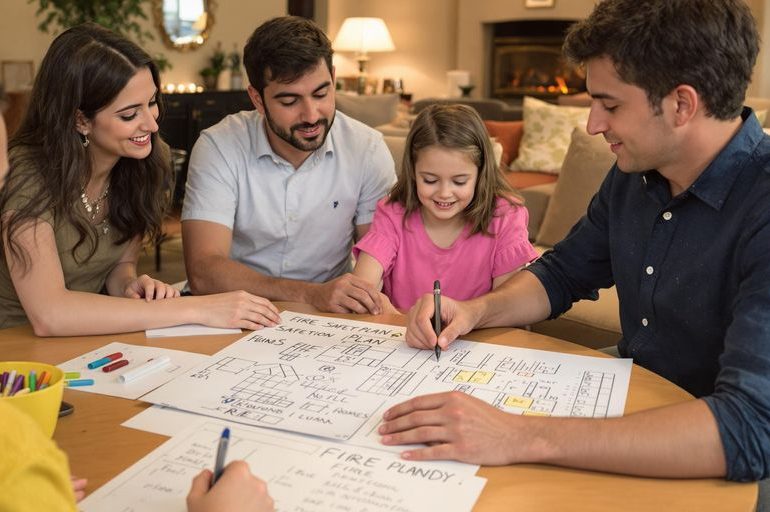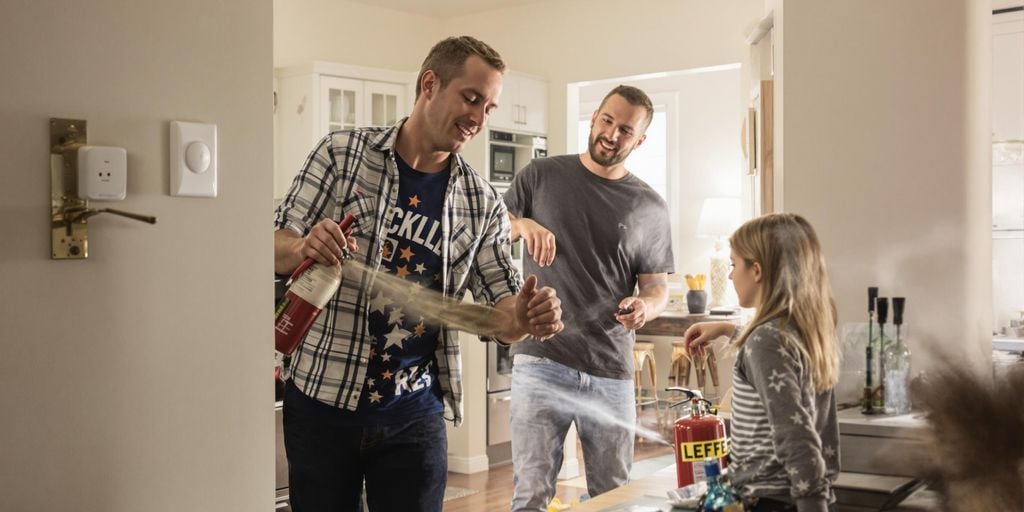Fires can happen when you least expect them, and they can turn your life upside down in minutes. That’s why having a fire safety plan in place is so important. Whether it’s about preventing fires, knowing how to escape, or teaching your family what to do in an emergency, a little preparation can go a long way. In this guide, we’ll cover practical tips and steps to help you protect your home and loved ones.
Key Takeaways
- A fire safety plan is essential for every household to minimize risks and prepare for emergencies.
- Common fire hazards include kitchen mishaps, faulty electrical systems, and heating equipment.
- Regularly practicing fire escape drills ensures everyone knows what to do in case of a fire.
- Equip your home with smoke alarms, fire extinguishers, and carbon monoxide detectors.
- Teaching children and family members about fire safety can save lives.
Understanding the Basics of Fire Prevention
Common Causes of House Fires
Fires can happen in the blink of an eye, and the causes are often things we overlook. Most house fires start in the kitchen, where cooking mishaps can quickly turn dangerous. Leaving food unattended on the stove or having flammable items like paper towels or curtains too close to heat sources is a recipe for trouble. Electrical issues are another big culprit—overloaded outlets, damaged cords, or flickering lights could all spell danger. Lastly, heating equipment like space heaters or fireplaces can ignite nearby items if not used carefully.

Tips for Preventing Kitchen Fires
- Never leave cooking food unattended. Even stepping away for a minute can lead to disaster.
- Keep flammable items—like paper towels, curtains, or clothing—far from stoves and other heat sources. Prevent fires by storing flammable items safely.
- Regularly clean grease buildup from stovetops and ovens, as it can catch fire.
- Always have a lid nearby to smother small grease fires. Never use water on these fires—it’ll make things worse.
Electrical Safety Measures
Electrical fires are sneaky and can happen when you least expect it. Here’s how to stay safe:
- Don’t overload power outlets or use too many extension cords in one spot.
- Inspect cords and plugs for wear and tear—replace anything frayed or damaged.
- Turn off and unplug appliances when not in use, especially high-wattage ones like toasters or space heaters.
- If you notice flickering lights, burning smells, or sparking, call a professional to check your wiring.
Fire prevention isn’t just about being careful—it’s about being proactive. Taking small steps now can save lives and property later.
Creating a Comprehensive Fire Escape Plan
Mapping Out Escape Routes
Planning your escape routes is the cornerstone of any fire safety plan. Start by sketching a floor plan of your home, marking all doors and windows. Every room should have at least two exits—one primary and one backup. For example, if the door is blocked, a window can serve as an alternative exit. Make sure windows are easy to open and free of obstructions.
- Keep hallways and doorways clear of clutter.
- Install escape ladders for second-story bedrooms.
- Check that everyone in the household, including kids, knows how to unlock windows and doors quickly.
Designating a Family Meeting Spot
Once outside, you need a safe spot where everyone can gather. Choose a location that is easy to remember and far enough from the house to avoid danger—like a tree, a mailbox, or a neighbor’s driveway. Make sure every family member knows this spot by heart. Knowing where to meet helps you confirm everyone is safe and avoids unnecessary risks of re-entering the house.
Practicing Fire Drills Regularly
A plan is only as good as the practice behind it. Schedule fire drills at least twice a year—once during the day and once at night. Time how long it takes for everyone to get out of the house and aim to improve with each drill.
Here’s a quick checklist for your drills:
- Ensure everyone uses their designated escape routes.
- Practice crawling low under smoke to avoid inhalation.
- Test opening windows and using escape ladders where applicable.
Practicing regularly builds confidence and muscle memory, ensuring your family can act quickly and calmly in an actual emergency.
By following these steps, you’ll have a fire escape plan that’s not just written down but truly ready to save lives. For more advice on safeguarding your home, check out this guide on developing a thorough fire safety plan.
Essential Fire Safety Equipment for Every Home

Installing and Maintaining Smoke Alarms
Smoke alarms are your first line of defense against fires. Make sure you have one installed on every level of your home, in hallways, and inside each bedroom. Test them monthly to ensure they’re working properly, and replace the batteries at least once a year. Don’t forget to replace the entire unit every 10 years, as older alarms may not function as effectively.
Choosing the Right Fire Extinguishers
Fire extinguishers are a must-have. Keep at least one on every floor, and definitely have one in the kitchen since that’s where most home fires start. The most common type for households is the ABC extinguisher, which can handle different types of fires. Remember the PASS technique: Pull the pin, Aim at the base of the fire, Squeeze the handle, and Sweep side to side. Practice using one so you’re not fumbling during an emergency.
The Importance of Carbon Monoxide Detectors
Carbon monoxide is a silent threat—it’s odorless and invisible. Place detectors near sleeping areas and on every level of your home. Like smoke alarms, test them regularly and replace their batteries annually. These devices can alert you to dangerous gas levels, giving you time to act before it’s too late.
Equipping your home with these tools isn’t just about following safety guidelines—it’s about protecting your loved ones and giving yourself peace of mind.
Teaching Fire Safety to Your Family
Educating Children About Fire Risks
Children are naturally curious, so it’s essential to teach them about the dangers of fire in a way they can understand. Start with the basics: explain that fire is hot, spreads quickly, and can hurt people. Show them matches, lighters, and candles, and emphasize that these are not toys. Keep these items stored securely and out of reach.
A few things to focus on:
- Teach kids to never hide during a fire. Instead, they should call for help and follow the escape plan.
- Explain the importance of staying low to the ground to avoid smoke inhalation.
- Make sure they know how to recognize the sound of a smoke alarm and what to do when they hear it.
Training Family Members on Emergency Procedures
Everyone in the house should know what to do in case of a fire. This means going over the fire escape plan regularly and ensuring everyone knows their role. For example:
- Teach adults and older kids how to use a fire extinguisher properly.
- Make sure everyone knows how to test doors for heat before opening them.
- Discuss what to do if someone’s clothes catch fire—stop, drop, and roll until the flames are out.
Additionally, ensure that each family member knows emergency numbers like 911. For younger kids, practice dialing it on a toy phone or a deactivated device.
Role-Playing Fire Scenarios for Preparedness
Practicing what to do in a fire emergency can make a big difference when it really counts. Set up family fire drills at least twice a year. During these drills:
- Pretend there’s smoke and have everyone crawl low to the ground.
- Time the evacuation to see how quickly everyone can get out.
- Practice using secondary exits like windows if the main door is blocked.
Being prepared isn’t just about knowing what to do—it’s about building confidence so everyone can act quickly and calmly in an emergency.
Finally, designate a safe meeting spot outside the home, like a tree or mailbox, where everyone will gather after evacuating. Make sure it’s far enough away from the house but easy for everyone to find. Regular practice and clear communication can save lives.
What to Do During a Fire Emergency
Evacuating Safely and Quickly
When a fire breaks out, every second counts. The moment you hear the smoke alarm or notice signs of fire, act fast. Alert everyone in the house and stick to your pre-planned escape routes. Don’t waste time grabbing personal items—your safety is the priority. Always check doors with the back of your hand before opening them. If a door feels hot, avoid it and use an alternate route.
- Move swiftly but stay calm.
- Crawl low under smoke to avoid inhaling toxic fumes.
- Close doors behind you as you leave to slow the fire’s spread.
Once outside, head straight to your designated meeting spot, such as a tree or mailbox, that’s a safe distance from your home.
Using the Stop, Drop, and Roll Technique
If your clothes catch fire, this simple yet effective technique could save your life:
- Stop moving immediately to avoid fanning the flames.
- Drop to the ground and cover your face with your hands.
- Roll over and over to extinguish the flames.
This method works best when done on a flat surface, so avoid standing or running, which can make the fire worse.
Calling Emergency Services Immediately
Once you’re safely outside, call 911 or your local emergency number. Be clear and concise when providing your address and details about the fire. Under no circumstances should you re-enter the building. Leave firefighting to the professionals.
Staying informed about emergencies can make a big difference. Consider signing up for Notify NYC to receive real-time updates and alerts, including fire emergencies and weather warnings.
By knowing these steps and practicing them regularly, you can protect yourself and your loved ones during a fire emergency.
Reducing Fire Hazards in Your Home
Identifying Flammable Materials
Flammable materials can be found in almost every home, and knowing where they are is the first step to reducing fire risks. Here’s what to look for:
- Household Chemicals: Items like cleaning supplies, paint, and gasoline should be stored in well-ventilated areas away from heat sources.
- Fabric and Paper: Curtains, rugs, and stacks of newspapers can ignite quickly. Keep these items away from fireplaces, heaters, and stoves.
- Cooking Oils: These can catch fire if overheated. Always monitor their use and store them properly.
Organizing Storage Areas Safely
Cluttered spaces can turn small sparks into major fires. To keep your home safe, follow these tips:
- Declutter regularly, especially in attics, basements, and garages.
- Store flammable items like propane tanks and paint cans in cool, dry places far from electrical outlets or heat sources.
- Avoid stacking items too high, as this can block airflow and create fire risks.
Taking the time to organize your storage areas not only reduces fire hazards but also makes your home feel more spacious and manageable.
Maintaining Heating and Electrical Systems
Your home’s heating and electrical systems are essential but can also be dangerous if neglected. Here’s how to keep them safe:
- Inspect Wiring: Look for frayed or damaged cords and replace them immediately. Don’t overload outlets or use too many extension cords.
- Space Heaters: Keep them at least three feet away from anything flammable, and never leave them running when unattended.
- Chimneys and Fireplaces: Clean them annually to prevent creosote buildup, which can cause chimney fires.
By addressing these areas, you can significantly lower the risk of a fire in your home. For instance, installing smoke alarms on every level and testing them monthly is a simple yet effective way to enhance safety.
Conclusion
Creating a fire safety plan for your home might seem like a lot of work, but it’s one of those things you’ll be grateful for if the unexpected happens. Fires don’t give warnings, and being prepared can make all the difference. From spotting hazards to practicing escape routes, every step you take adds a layer of protection for your family. So, take the time to put a plan in place, check your safety equipment, and talk it over with everyone in your household. It’s a small effort now that could save lives later. Stay safe, and remember, preparation is key.
Frequently Asked Questions
What are the main causes of house fires?
Most house fires start in the kitchen, often due to unattended cooking. Electrical issues, such as overloaded outlets or damaged cords, and heating equipment placed too close to flammable items, are also common causes.
How often should smoke alarms be tested and maintained?
Smoke alarms should be tested once a month to ensure they are working properly. Replace the batteries at least once a year and replace the entire unit every ten years.
What is the best way to create a fire escape plan?
Identify two exits from every room, such as doors and windows. Keep escape routes clear, and designate a safe meeting spot outside. Practice fire drills twice a year, including during nighttime.
What should I do if my clothes catch on fire?
If your clothes catch fire, stop where you are, drop to the ground, and roll over to smother the flames. Cover your face with your hands to protect it while rolling.
Why is a family meeting spot important during a fire emergency?
A family meeting spot ensures everyone knows where to gather after escaping. This helps you quickly confirm that everyone is safe and avoids confusion during an emergency.
What fire safety equipment should every home have?
Every home should have smoke alarms, fire extinguishers, and carbon monoxide detectors. For multi-story homes, fire escape ladders are also essential. Regularly check and maintain this equipment.

